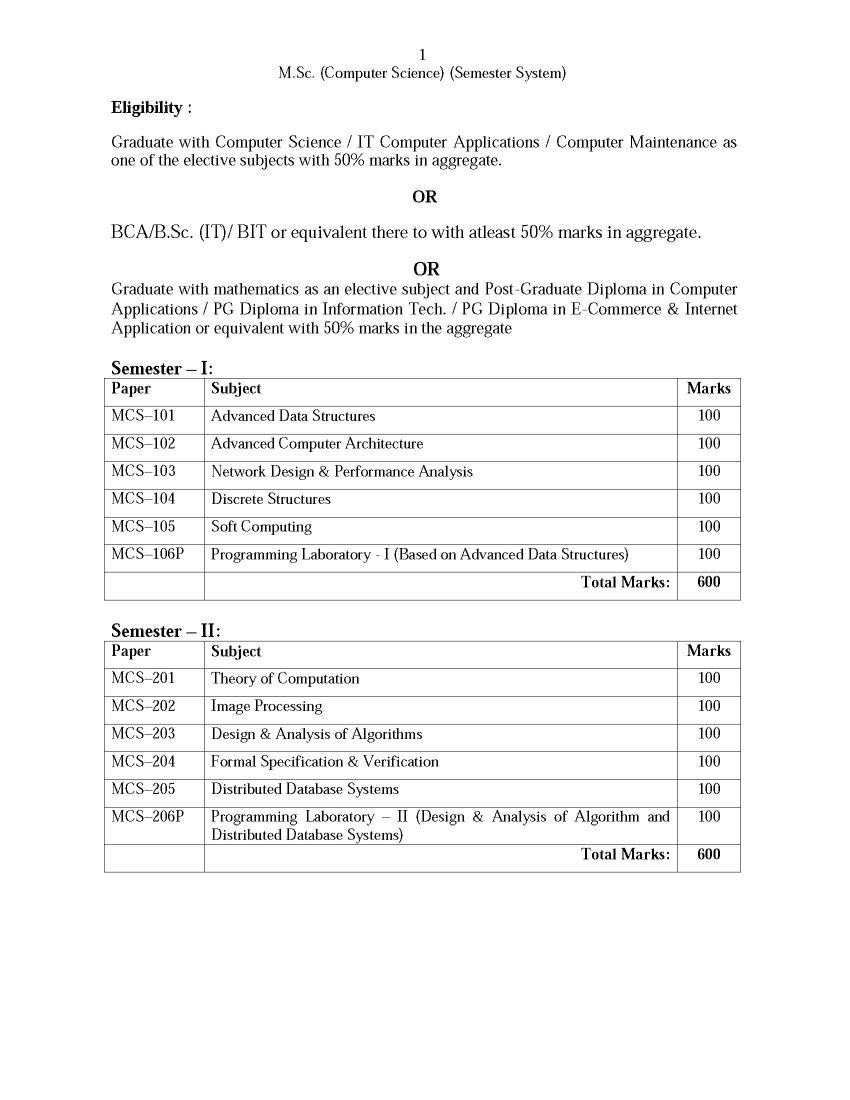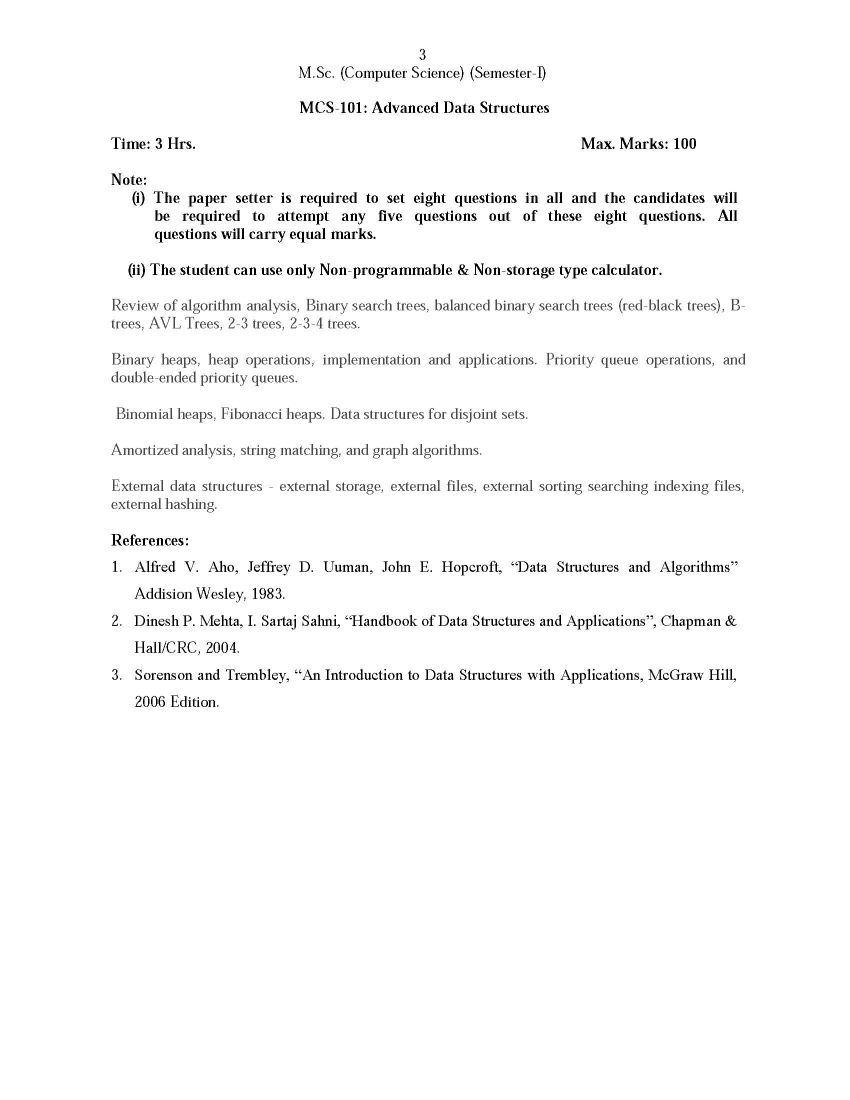| Re: GNDU MSC CS Syllabus
As you want I am here giving you syllabus for M.Sc. (Computer Science) course of Guru Nanak Dev University,Amritsar (GNDU).
Syllabus :
Semester 1 :
Advanced Computer Architecture
Network Design & Performance Analysis
Discrete Structures
Soft Computing
Programming Laboratory - I (Based on Advanced Data Structures)
Semester 2:
Theory of Computation
Image Processing
Design & Analysis of Algorithms
Formal Specification & Verification
Distributed Database Systems
Programming Laboratory – II (Design & Analysis of Algorithm and Distributed Database )
Semester 3:
Advanced Software Engineering
System Software
Data Mining and Warehousing
Concept of Core and Advanced Java
Network Programming
Programming Laboratory -III (Based on Advanced Java and Network Programming)
GNDU MSC CS Syllabus
MCS-101: Advanced Data Structures
(i) The paper setter is required to set eight questions in all and the candidates will
be required to attempt any five questions out of these eight questions. All
questions will carry equal marks.
(ii) The student can use only Non-programmable & Non-storage type calculator.
Review of algorithm analysis, Binary search trees, balanced binary search trees (red-black trees), Btrees,
AVL Trees, 2-3 trees, 2-3-4 trees.
Binary heaps, heap operations, specifications, implementation and applications. Advanced heap
structures, priority queue operations, and double-ended priority queues.
Dictionaries, binomial heaps, Fibonacci heaps. Data structures for disjoint sets, tables and table
operations.
Amortized analysis, string matching, and graph algorithms.
External data structures - external storage, external files, external sorting searching indexing files,
external hashing.
References:
Alfred V. Aho, Jeffrey D. Uuman, John E. Hopcroft, “Data Structures and Algorithms” Addision
Wesley, 1983.
Dinesh P. Mehta, I. Sartaj Sahni, “Handbook of Data Structures and Applications”, Chapman &
Hall/CRC, 2004.
Sorenson and Trembley, “An Introduction to Data Structures with Applications, McGraw Hill,
2006 Edition.
M.Sc. (Computer Science) (Semester-I)
Note:
(i) The paper setter is required to set eight questions in all and the candidates will
be required to attempt any five questions out of these eight questions. All
questions will carry equal marks.
(ii) The student can use only Non-programmable & Non-storage type calculator.
Paradigms of Computing: Synchronous – Vector/Array, SIMD, Systolic
Asynchronous – MIMD, reduction Paradigm, Hardware taxanomy: Flynn’s classification, Software
taxanomy: Kung’s taxanomy, SPMD.
Parallel Computing Models
Parallelism in Uniprocessor Systems: Trends in parallel processing, Basic Uniprocessor
Architecture, Parallel Processing Mechanism.
Parallel Computer Structures: Pipeline Computers, Array Computers, Multiprocessor Systems
Architectural Classification Schemes: Multiplicity of Instruction-Data Streams, Serial versus
Parallel Processing, Parallelism versus Pipelining
Pipelining : An overlapped Parallelism, Principles of Linear Pipelining, Classification of Pipeline
Processors, General Pipelines and Reservation Tables
References
Computer Architecture and Parallel Processing, Faye A. Briggs, McGraw-Hill International, 2007
Edition
Computer Systems Organization & Architecture, John d. Carpinelli, Addison Wesley, 2007 Edition.
M.Sc. (Computer Science) (Semester-I)
Time: 3 Hrs. Max. Marks: 100
Note:
(i) The paper setter is required to set eight questions in all and the candidates will
be required to attempt any five questions out of these eight questions. All
questions will carry equal marks.
(ii) The student can use only Non-programmable & Non-storage type calculator.
Requirements, planning, & choosing technology: System requirements, traffic sizing
characteristics time & delay consideration.
Traffic engineering and capacity planning: Throughput calculation traffic characteristics
&source models, traditional traffic engineering, queued data & packet switched traffic
modeling, designing for peaks, delay or latency
Network performance modeling- Creating traffic matrix, design tools, components of design
tools, types of design projects.
Technology Comparisons- Generic packet switching networks characteristics, private vs.
public networking, Business aspects of packet, frame and cell switching services, High speed
LAN protocols comparison, Application performance needs, Throughput, burstiness,
response time and delay tolerance, selecting service provider, vendor, service levels etc.
Access Network Design- N/W design layers, Access N/W design, access n/w capacity,
Backbone n/w design, Backbone segments, backbone capacity, topologies, Tuning the
network, securing the network, Design for network security.
Documentation and network management- Documentation, network management, SNMP,
RMON
Network Optimization- Network optimization theory: Goals of network optimization,
measurements for network optimization, optimization tools, optimization techniques.
References:
James D. McCabe, Network Analysis, Architecture and Design, 2nd Edition, Morgan
Kaufman Series in Networking, 2007 Edition.
Youeu Zheng, Shakil Akhtar, Network for Computer Scientists and Engineers, Indian
University, Oxford University Press, 2007 Edition.
A. Forouzan, Data Communications and Networking, Tata McGraw Hill, 2007 Edition.
M.Sc. (Computer Science) (Semester-I)
Note:
(i) The paper setter is required to set eight questions in all and the candidates will
be required to attempt any five questions out of these eight questions. All
questions will carry equal marks.
(ii) The student can use only Non-programmable & Non-storage type calculator.
Graph Theory: Graph - Directed and undirected Eulerian chains and cycles. Hamiltonian
chains and cycles Trees, Chromatic number Connectivity and other graphical parameter.
Application.
Combinatorial Mathematics: Basic counting principles Permutations and combinations
Inclusion and Exclusion Principle Recurrence relations, generating Function, Application.
Sets and Functions : Sets relations functions operations equivalence relations, relation of
partial order partitions binary relations.
Monoids and Groups: Groups Semigroups and monoids Cyclic semigraphs and
submonoids, Subgroups and Cosets. Congruence relations in semigroups. Morphisms.
Normal subgroups. Structure of Cyclic groups permutation groups, dihedral groups
Elementary applications in coding theory.
Rings and Boolean algebra : Rings Subrings morphism of rings ideals and quotient rings.
Euclidean domains Integral domains and fields Boolean Algebra direct product morphisms
Boolean sub-algebra Boolean Rings Application of Boolean algebra in logic circuits and
switching functions.
References :
Ehrig, H., Mahr, B. Fundamentals of Algebraic Specification I, EATCS Monographs on
Theory. Comp. Sc. Vol. 6 spinger, Berlin 1985.
Gersting J. Mathematical Structures for Computer Science, W.H. Freeman, New York,
1987.
Gibbons, A. Algorithmic Graph theory Cambridge University Press, 1985.
Knuth, D.E. The art of Computer Programming Vol. I: Fundamental Algorithms. 2nd ed.
Reading, Mass, Addison Wesley 1973.
Kolman B. Busby R. Discrete Mathematical Structures for Computer Science, Prentice Hall
Englewood Cliffs. 1987.
Sahni, S. Concepts in Discrete Mathematics Fridley MN., Camelot Publ. Comp., 1981.
Schmidt G. Strohlein T. Relations Graphs Program, EATS Monograph on Theor. Comp.
Sc. Vol. 29 Berlin Spinger 1993.
Wheeler W. Universal Algebra for Computer Scientist EATCS Monographs on Theor.
Comp. Sc. Vol. 25 Spinger-Verlag, Berlin 1991.
M.Sc. (Computer Science) (Semester-I)
Note:
(i) The paper setter is required to set eight questions in all and the candidates will
be required to attempt any five questions out of these eight questions. All
questions will carry equal marks.
(ii) The student can use only Non-programmable & Non-storage type calculator.
Neural Networks
Introduction to neural networks, working of an artificial neuron, linear seperability,
perceptron, perceptron training algorithm, back propagation algorithm, adalines and
madalines.
Supervised and unsupervised learning, counter-propagation networks, adoptive resonance
theory, neocognitron and bidirectional associative memory.
Fuzzy Logic
Introduction to fuzzy logic and fuzzy sets, fuzzy relations, fuzzy graphs, fuzzy arithmetic and
fuzzy if-then rules.
Applications of fuzzy logic, neuro-fuzzy systems and genetic algorithm.
Probabilistic Reasoning
Introduction to probability theory, conditional probability, Baye’s theorem, random variables
and expectations.
Probability distributions, various types of probability distributions like joint distributions,
normal distributions etc., fuzzy logic and its relationship with probability theory.
References:
Elements of artificial neural networks by Kishan Mehrotra, Chilkuri K. Mohan and Sanjay
Ranka, 2007 Edition.
Fundamentals of artificial neural networks by Mohammad H. Hassoun, Prentice Hall of
India, 2007 edition.
Neural networks and fuzzy systems by Bart Kosko, Prentice Hall of India, 2007 edition.
Fuzzy logic, intelligence, control and information by John Yen and Reza Langari, Pearson
Education, 2007 edition.
Probability and statistics by Murray R. Spiegel, John Schiller and R. Alu Srinivasan,
Schaum’s Outlines, Tata McGraw Hill Publishing Company Limited, 2007 edition.
M.Sc. (Computer Science) (Semester-I)
Programming Laboratory - I
Time: 3 Hrs. Max. Marks: 100
Programs based on Advanced Data Structures using C/C++
9
M.Sc. (Computer Science) (Semester-II)
Note:
(i) The paper setter is required to set eight questions in all and the candidates will
be required to attempt any five questions out of these eight questions. All
questions will carry equal marks.
(ii) The student can use only Non-programmable & Non-storage type calculator.
Operations on Languages: Closure properties of Language Classes. Context Free
Languages: The Chomsky Griebach Normal Forms. Linear Grammars and regular
Languages. Regular Expressions Context Sensitive Languages; The Kuroda Normal Form,
One sided Context Sensitive Grammars.
Unrestricted Languages: Normal form and Derivation Graph, Automata and their
Languages: Finite Automata, Push down Automata and Turing Machines, The Equivalence
of the Automata and the appropriate grammars.
Syntax Analysis: Ambiguity and the formal power Series, Formal Properties of LL(k) and
L.R.(k) Grammars.
Derivation Languages: Rewriting Systems, Algebraic properties, Canonical Derivations,
Context Sensitivity.
Cellular Automata: Formal Language aspects, Algebraic Properties Universality &
Complexity Variants.
References:
1. G.E. Reevsz, Introduction to Formal Languages, McGraw Hill 1983.
2. M.H. Harrison, Formal Language Theory Wesley 1978.
3. Wolfman Theory and Applications of Cellular Automata, World Scientific,
Singapore, 1986.
4. K.L.P. Mishra, N. Chandrasekaran, Theory of Computer Science (Automata,
Languages and Computation), 2nd Edition, Prentice Hall of India, 2006.
10
M.Sc. (Computer Science) (Semester-II)
Note:
(i) The paper setter is required to set eight questions in all and the candidates will
be required to attempt any five questions out of these eight questions. All
questions will carry equal marks.
(ii) The student can use only Non-programmable & Non-storage type calculator.
Background: Introduction to electronic systems for image transmission and storage, computer
processing and recognition of pictorial data, overview of practical applications.
Fundamentals: Mathematical and perceptual preliminaries, human visual system model, image
signal representation, imaging system specification building image quality, role of computers,
image data formats.
Image Processing Techniques: Image enhancement, image restoration, image feature extraction,
image data compression and statistical pattern recognition.
Hardware architecture for image processing: Distributed processing of image data, role of array
processing, standard image processor chips (as example).
Techniques of Colour Image Processing: Colour image signal representation, colour system
transformations, extension of processing techniques to colour domain.
Applications of Image Processing: Picture data archival, machine vision, medical image
processing.
References:
1. Pratt, W.K. Digital Image Processing, John Wiley, N.Y./1978.
2. Rosenfield, A and Kak, A.C., Picture processing, Academic Press N.Y., 1982.
3. Jain, A.K., Fundamentals of Digital Image Processing, Englewood Cliffs, Prentice Hall,
1989.
4. Chris Soloman, Stuart Gibson, Fundamentals of Digital Image Processing: A Practical
Approach using MatLab, John Wiley and Sons, 2007.
5. Digital Image Processing by Gonzalez & Wood, Addison Wesley, 2000.
Here is the attchment.
|



